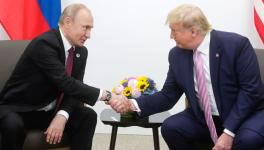2020 US-Taliban Accord Overshadows Afghan Peace Process
Representational use only.
Gholam Ruhani is a Taliban leader who led the outfit’s brigade that captured Kabul on August 15. Held for eight years at the Guantanamo Bay detention centre, he was among the 13 Afghan prisoners released in December 2007 after a military review concluded that he posed a “medium” risk to the US and its allies. Ruhani was released even after he reportedly told US military interrogators that he was a Taliban member and his brother-in-law was the outfit’s chief of intelligence.
In 2015, five top Talibs were released from Gitmo in exchange for the release of a US Army sergeant. Those released were Mullah Mohammad Fazl, former Taliban chief of staff; Mullah Norullah Noori, a close associate of dead Taliban co-founder and its first supreme commander Mullah Muhammad Omar; Abdul Haq Wasiq, former Taliban deputy intelligence chief; and top Taliban members Khirullah Said Wali Khairkhwa and Muhammad Nabi.
Abu Bakr al-Baghdadi, an Iraqi terrorist who became the first chief (amir) of the Islamic State of Iraq and the Levant (ISIL)—now known as the Islamic State—in 2014, was released from the US Camp Bucca prison in 2004. Detained for ten months, he was released for being a “low-level” prisoner. Some years later, the US announced a $25 million reward for information that could lead to his recapture. Al-Baghdadi, however, committed suicide during a raid by the US Delta Force and Army Rangers in Barisha, near Idlib, in Syria, in October 2019.
These were among the thousands of terrorists released from American prisons over the last years. Many such leaders and cadre now form the backbone of the Taliban’s fighting machine and its allied outfits like al Qaeda and the Islamic State, particularly its Khorasan unit. These fighters are in addition to the hundreds who have been freed from the prisons across Afghanistan in the recent raids by the marauding Taliban.
US OVERT OR COVERT AGREEMENTS WITH TERROR OUTFITS
The release of such prisoners, many of them being of critical importance, by the US and NATO forces have been mostly carried out as part of some overt or covert agreements/arrangements the US military or intelligence authorities have had with these outfits.
One of the most important agreements was the one between the former Donald Trump administration and the Taliban on February 29, 2020, titled the ‘Agreement for Bringing Peace to Afghanistan between the Islamic Emirate of Afghanistan which is not recognised by the United States as a state and is known as the Taliban, and the United States of America’.
After taking over large parts of the country, the Taliban wants to establish an ‘Islamic Emirate of Afghanistan’. The agreement, among other things, sets out a course for the withdrawal of US forces, the release of prisoners by both sides, denial of space to foreign terrorist groups by the Taliban, no violence against the US and its allies and an intra-Afghan dialogue.
India had sent its representative, then-ambassador to Qatar, P Kumaran, to these talks. The 2020 agreement was arrived at ahead of the latest intra-Afghan negotiations between the outfit and the Afghan government in Doha. The 2020 accord essentially called for the removal of US and coalition forces from Afghanistan in exchange for the promise that the Taliban would not allow terrorist groups to operate on Afghan soil.
The pact assumed a functioning Afghan government in Kabul for negotiations. It also laid down a timeframe for US withdrawal starting with clearing of five military bases and releasing thousands of Taliban prisoners. Besides asking the Taliban to guarantee democratic and human rights and release its prisoners, it also stated that Washington will start diplomatic discussions with the United Nations to remove members of the Taliban from the ‘sanctions list’.
The recent takeover of Afghanistan by the Taliban—province by province and mostly without resistance—immediately followed the intra-Afghan peace talks this year as if it was planned. Provinces fell like dominoes with the Afghan National Army in most places practically putting up no fight.
The shocking series of defeats primarily occurred due to the sudden withdrawal of the US troops and the Afghan military units surrendering, mainly due to the serious shortage of arms and supplies and the disbanding of its communication system by the withdrawing American forces. It was as if the Taliban forces were waiting to attack when the US withdrew its forces and dismantled its bases and infrastructure.
QUESTIONS REGARDING THE 2020 AGREEMENT
The Afghan government was neither a part of these negotiations nor a signatory to the agreement. Although the US side made an effort to keep then-President Ashraf Ghani informed and onboard, the Taliban insisted that the Afghan government should be excluded as it was not legitimate—and it prevailed.
A closer look at the 2020 agreement’s text shows that there could be considerable grounds for worry for the Indian government. Security experts term this accord as “entirely one-sided”, saying the militant outfit cannot be expected to uphold their side of the deal. “Taliban cannot deliver on its promises and yet the US has handed over Afghanistan to them. There is no reference to the Constitution, rule of law, democracy and elections,” one of them said.
A major point of concern is whether India is included in the definition of the term ‘US and its allies’. As per the agreement, the Taliban has guaranteed “enforcement mechanisms that will prevent the use of the soil of Afghanistan by any group or individual against the security of the United States and its allies”. Whether Pakistan-backed groups that threaten India would operate in Afghanistan is to be seen.
The impact of the release of thousands of Taliban prisoners is also of serious concern. This includes the “mainstreaming of the Haqqani network” with whom Lashkar-e-Taiba terrorists are reportedly aligned. This network was also allegedly responsible for the 2008 bombing of the Indian embassy in Kabul. Primarily based in North Waziristan region of Pakistan, it conducts cross-border operations in eastern Afghanistan and Kabul.
The accord also mentions a timeline for the withdrawal of US forces and a commitment to clearing five bases and bringing troop levels significantly down. The agreement also indicated submission to the possibility of a Taliban-led government thereby appearing to sideline the intra-Afghan dialogue taking place in Doha. The experts asked whether Trump had “surrendered Afghanistan to the Taliban”.
The agreement also raises questions over the new dispensation that is now emerging in Kabul with the Taliban holding the leash. The issue of whether Afghanistan will remain a democracy would continue to bother India, which cannot look at the situation through the eyes of the US, the experts said.
On its part, the Taliban is not a single united organisation but a coalition of various commanders and militias across Afghanistan with conflicting ideas about the war and the agreement. The Taliban leaders who negotiated the agreement are from the outfit’s leadership group, referred to as the Quetta Shura, which operates out of Pakistan and is largely a political and economic organisation.
The Shura reportedly controls the very profitable opium and heroin trade that funds the Taliban’s military operations. The Shura is led by senior Taliban leaders like its present chief Haibutullah Akhundzada, Mohammed Yaqub, Mohammed Omar and the outfit’s co-founder Abdul Ghani Baradar.
Although these leaders wield tremendous power within Taliban, they have little or no military experience and are therefore distrusted by the commanders in the field. These commanders are generally younger than the leadership of Shura. Thanks to these regional commanders, the Taliban now controls almost the entire country. Whether they would continue to obey the directives of their ‘elders’ (Shura) remains to be seen.
According to the experts, New Delhi has been a strong supporter of the erstwhile Afghan governments and invested $3 billion in infrastructure development and businesses in Afghanistan since 2001. Its main goals are to minimise Pakistan’s influence and prevent Afghanistan from becoming a haven for anti-India militants.
New Delhi has been maintaining that it would like the peace process to be inclusive—Afghan-led, Afghan-owned and Afghan-controlled. It has been a stakeholder in the peace and reconciliation process in Afghanistan though it has not conducted any official negotiation with the Taliban. India wants to ensure that such a process should not lead to any “ungoverned spaces” where terrorists and their proxies can relocate. It has also conveyed to the US that the pressure on Pakistan to crack down on terror networks operating from its soil must be maintained.
(Amitabha Roychowdhury was the deputy executive editor of Press Trust of India and has extensively covered internal security, defence and civil aviation. The views are personal.)
Get the latest reports & analysis with people's perspective on Protests, movements & deep analytical videos, discussions of the current affairs in your Telegram app. Subscribe to NewsClick's Telegram channel & get Real-Time updates on stories, as they get published on our website.
























